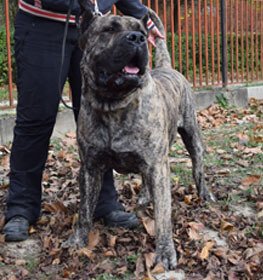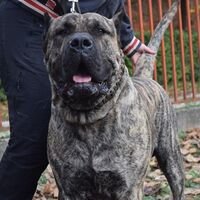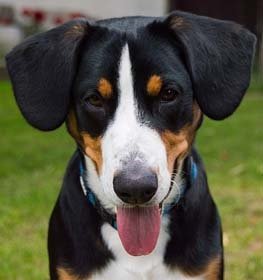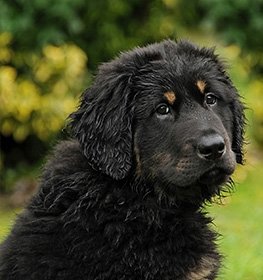Perro de Presa Canario Information & Dog Breed Facts
Collection of all the general dog breed info about Perro de Presa Canario so you can get to know the breed more.
| Group | Guard Dogs |
|---|---|
| Popularity Rank | 439 |
| Reviews | 5 |
| User Ratings | |
|
Compare the Perro de Presa Canario With Other Dogs
Select at least one dog breed to make the comparsion. | |
 | |
| Origin | |
|
Common Names & Aliases
What other names is a Perro de Presa Canario known by? Discover all traditional, regional and informal names used for this breed. | Canarian MolosserCanary MastiffDogo CanarioPresaPresa CanarioCanary Catch Dog |
|---|---|
|
Breed Classification
What type of dog breed is a Perro de Presa Canario? Learn about its genetic classification and breeding category. | Cross Breed |
Photo Gallery of the Perro de Presa Canario Breed
|
Size Classification
What size category is a Perro de Presa Canario? Learn how big the Perro de Presa Canario breed typically grows. | Large |
|---|---|
|
Weight Statistics
How much does a Perro de Presa Canario weigh? Discover typical weight ranges for adult males and females of the Perro de Presa Canario breed. | 80-100 pounds (36-45 kg) |
|
Average Weight
What is the average weight of a Perro de Presa Canario? | 90 pounds (40.5 kg) |
|
Height
How tall is the Perro de Presa Canario? Perro de Presa Canario height: | 21-25 inches (55-65 cm) |
|
Average Height
What is the average height of a Perro de Presa Canario? | 23 inches (60 cm) |
|
Price Range
How much does a Perro de Presa Canario puppy cost? Find current market prices and factors affecting Perro de Presa Canario costs. | $1200-$3000 If you choose to purchase the Perro de Presa Canario, you should know that the mentioned amount of money is an average of the collected data from breeders’ sites and puppy finder places. If you have a Perro de Presa Canario for sale, please advertise it on a reliable website to make sure the Perro de Presa Canario gets to a happy place. |
|---|---|
|
Availability
How easy is it to get a Perro de Presa Canario? How many Perro de Presa Canario are there in the world? | Rare: You may rarely see each other in everyday life, but you might catch a glimpse of each other at dog shows. There are very few of them, and there have been times when they have almost drifted to the brink of extinction, so few are left. |
|
Intelligence Rating
How intelligent is a Perro de Presa Canario? Discover the Perro de Presa Canario's intelligence ranking and learning capabilities. | Average: It takes patience to teach this breed any tricks or commands, but the effort is worth it. They understand and remember new commands after an average of 25-40 repetitions.
The Perro de Presa Canario ranks average in the intelligence ranking of dogs. |
|---|---|
|
Training Difficulty
How easy is it to train a Perro de Presa Canario? Learn about the Perro de Presa Canario's trainability and response to training methods. | Perro de Presa Canario dogs are quite easy to train. Sometimes they can be challenging, but if you're consistent in teaching new commands they will obey for sure. |
|
Watchdog Rating
How good is a Perro de Presa Canario as a watchdog? Learn about the Perro de Presa Canario's alertness and guarding instincts. | Perro de Presa Canario dogs are one of the best watchdogs. Their main job is to observe and they're very consistent in their effort. The best vocal cords and sense of hearing belong to them. Usually, they're very territorial and protective about their property, so the Perro de Presa Canario dogs will alert you if they sense something different. |
|
Territorial Protection
Is a Perro de Presa Canario protective of its territory? Learn about the Perro de Presa Canario's guarding instincts and behavior. | Perro de Presa Canario dogs are extremely protective guard dogs. This breed doesn't hesitate to protect its territory so the Perro de Presa Canario can be a good choice if you want an excellent guard dog. Keep calm and the Perro de Presa Canario will take care of unwanted people or animals. |
|
Personality Traits
What personality does a Perro de Presa Canario have? Learn about characteristic Perro de Presa Canario temperament and behavior traits. | DominantGentleStrongWilledCalmSuspicious |
|---|---|
|
Sensitivity Level
How sensitive are they? Perro de Presa Canario sensitivity: | Perro de Presa Canario dogs have an average emotional level and are not the most sensitive dog breed. Sometimes it's okay to change the daily routine, have guests and listen to loud music.
Some dogs handle moderate punishment very well, while others crumble apart at a dirty look. This breed is not affected emotionally by moderate punishment. |
|
Affection Level
How affectionate are they? Is a Perro de Presa Canario a good family dog? | Average: Perro de Presa Canario dogs are average dogs regarding their affection level. Some breeds are forthcoming and friendly, while others are independent and don't bond too closely with their owners. |
|
Social Needs
How much social interaction does the Canarian Molosser need? Perro de Presa Canario social needs: | Perro de Presa Canario dogs need for social interaction is average. This breed likes being around people or other animals, but they don't mind being left alone for a few hours either. |
|
Impulse to Wander or Roam
How likely is the Perro de Presa Canario to run away? Does this breed explore or wander a lot? Does Perro de Presa Canario roam? | Perro de Presa Canario dogs have average wanderlust potential. Sometimes they like to explore the world and they might escape once or twice, but usually, they prefer staying safely at home. Safer to teach them how to get back to you on command. |
|
Prey Drive
Do this canine have a strong prey drive? Does Perro de Presa Canario have high prey drive? | Perro de Presa Canario dogs have a high impulse to chase and catch something. Cats or any other small animals are in danger. It's a natural instinct, doesn't necessarily mean that Perro de Presa Canario dogs are aggressive. Better to keep this breed on a leash. |
|
Barking Frequency
Does a Perro de Presa Canario bark a lot? Learn about typical Perro de Presa Canario vocalization patterns and triggers. | Low to Average: The Perro de Presa Canario rarely barks. This breed could be a good choice if you're looking for a quiet breed. They don't bark unless there is a good reason.
Top reasons for barking: protection, alarm, fear, boredom, attention-seeking, greeting, separation anxiety, compulsive barking. |
|---|---|
|
Playful Nature
How playful is a Perro de Presa Canario? Understand the typical play drive and energy level of the Perro de Presa Canario breed. | Average: Perro de Presa Canarios, like any other dog breed, like playing. Sometimes they bark in excitement for playing, but they are not the most playful dog breed. |
|
Apartment Adaptability
Can a Perro de Presa Canario live in an apartment? Learn about the Perro de Presa Canario's suitability for apartment living. | Not an apartment-friendly dog the Perro de Presa Canario breed. If you don't have a garden, think carefully about your decision, keeping Perro de Presa Canario indoors can cause a lot of problems. |
|
Lifestyle Adaptability
How adaptable is a Perro de Presa Canario to lifestyle changes? Learn about the Perro de Presa Canario's flexibility to new situations. | Perro de Presa Canario dogs don't adapt well to lifestyle changes and different living environments. They don't like moving from one place to another. |
|---|---|
|
Alone Time Tolerance
Can a Perro de Presa Canario be left alone? Learn about the Perro de Presa Canario's tolerance to solitude. | Just like every puppy, they are prone to panic, cry, bark, whine when they left alone by their owner. With proper socialization and quality time with the dog can solve this problem. |
|
Bite Risk Assessment
What is a Perro de Presa Canario biting potential? Learn about the Perro de Presa Canario's bite risk factors. | Low 🔽 The Perro de Presa Canario has a low chance of biting somebody. Top reasons for dog bite: protection, pain, excitement, herding instinct, being provoked. (Data based on the available online bite statistics.) |
|---|---|
|
Mouthing Tendency
Is a Perro de Presa Canario mouthy? Learn about the Perro de Presa Canario's tendency to use mouth during play. | Perro de Presa Canario dogs have an average tendency to nip, chew, playbite, or herd people. It's a common habit during puppyhood, not aggressive behavior. These "bites" don't hurt, but Perro de Presa Canario dogs need to be taught a good attitude. |
|
Bite Strength Rating
How strong is a Perro de Presa Canario bite? Learn about the Perro de Presa Canario's bite force measured in PSI. | Above 400 PSI 🔼 Perro de Presa Canario bite force: The Strongest. The Perro de Presa Canario bite force is among the strongest in the canine world. The bite force Perro de Presa Canario measurements are typically quite high, which is a testament to their powerful and large stature. The bite force of Perro de Presa Canario dogs is impressive, and their Perro de Presa Canario bite PSI is reflective of their powerful nature.
The Perro de Presa Canario PSI bite should be respected, and appropriate precautions should be taken when interacting with these dogs. The PSI of a Perro de Presa Canario bite is high, making them one of the strongest breeds in terms of bite force. They are very protective of themselves and their families, therefore a dog bite from them could be exceptionally dangerous with their PSI being above 400. To ensure a well-behaved and controlled dog, it's important to learn how to train a Perro de Presa Canario puppy not to bite from an early age. It is important that they’re trained to be around others safely. |
|
Average Lifespan
How long does a Perro de Presa Canario live? Learn about the typical lifespan of the Perro de Presa Canario breed. | 9-11 years The average lifespan of Perro de Presa Canario: 10 years |
|---|---|
|
Climate Tolerance
How well does a Perro de Presa Canario handle different weather? Learn about the Perro de Presa Canario's climate adaptability. | Tolerates warm and cold weather Dogs that tolerate hot and cold weather are typically those that have a double coat of fur. Dogs with a double coat of fur have a layer of fur that insulates their skin and helps protect them from the cold and the heat. |
|
Health Concerns
What health issues are common in a Perro de Presa Canario? Discover typical conditions affecting the Perro de Presa Canario breed. | Perro de Presa Canarios are commonly healthy dogs. Vet costs aren't expensive with this breed. |
|
Vet Care Frequency
How often does a Perro de Presa Canario need vet visits? Learn about the Perro de Presa Canario's veterinary care requirements. | Rare The Perro de Presa Canario should have a complete physical check-up at least every 12-18 months (but preferably once per year). If your dog shows any symptoms, call your veterinarian. |
|
Health Problems
What genetic/health problems does the Perro de Presa Canario breed have? What are the health issues and concerns of the Perro de Presa Canario breed? Most common health risks of Perro de Presa Canario: | Luxating PatellaHypothyroidismBloatDemodectic MangeCryptorchidismDilated CardiomyopathyObsessive Compulsive Disorder |
|
Energy Rating
How energetic is a Perro de Presa Canario? Understand daily activity needs of the Perro de Presa Canario breed. | Perro de Presa Canario dogs are high-energy dogs. An active lifestyle makes them happy. |
|---|---|
|
Activity Requirement / Exercise Need
How much exercise does a Perro de Presa Canario need? How much exercise do Perro de Presa Canario dogs require per day?
Do Perro de Presa Canario dogs need a lot of exercises? | Perro de Presa Canario dogs have an average exercise need. This breed is satisfied with short walks every weekday and a long ones on weekends. |
|
Sleeping Need
How much sleep does the Perro de Presa Canario breed need? | Perro de Presa Canario dogs don't need too much sleep. They are energetic and desire to live active life. If you think naps are overrated, this breed can be the best choice for you. |
|
Obesity Tendency
Is a Perro de Presa Canario prone to weight gain? Learn about the Perro de Presa Canario's obesity risks. | High: The Perro de Presa Canario breed has a strong tendency to be overweight. Try to find the happy medium between exercise and feeding. If you want to keep balance, increase the amount and frequency of your daily dog walk and play with the Perro de Presa Canario more often.
If you notice any weight gain, consult your veterinarian and make a diet plan. Reduce unhealthy food and snacks, and measure the Perro de Presa Canario weight regularly. |
|---|---|
|
Food Consumption
How much food does a Perro de Presa Canario need daily? Learn about the Perro de Presa Canario's feeding requirements. | 3 to 5 cups of a high-quality dog food daily, divided into two meals. |
|
Allergy Friendliness
Is a Perro de Presa Canario hypoallergenic? Learn about the Perro de Presa Canario's suitability for allergy sufferers. | No Perro de Presa Canario dogs don't do well with allergy sufferers by causing allergic reactions. Some dog breeds are even considered to higher possibility of an allergic response. Coat type isn't necessarily relevant, because most people are allergic to dander (flakes on the dog's skin) or saliva, not actually to dog hair. |
|---|---|
|
Coat Colors
What colors does a Perro de Presa Canario come in? Discover all possible Perro de Presa Canario color variations. | Black Red SilverFawn Brindle |
|
Grooming Requirements
How much grooming does a Perro de Presa Canario need? Learn about Perro de Presa Canario coat maintenance requirements. | Easy to groom: The Perro de Presa Canario doesn't require a lot of grooming. Seasonal flea treatment is needed, but cutting the dog's hair by a professional groomer isn't necessary. Ears and eyes should be cleaned regularly to avoid infections. Perro de Presa Canario is a good choice if you don't have the time, skill, or money to take care of a high-maintenance dog. Recommended for beginners. |
|
Drooling Tendency
Does a Perro de Presa Canario drool a lot? Learn about the Perro de Presa Canario's drooling habits. | The Perro de Presa Canario is an average drooler. Drooling is the unintentional saliva flowing outside of the mouth. It can be completely normal or a sign of a health problem.
If you notice any change in your dog's drooling habit, you should contact a vet as soon as possible. |
|
Stinkiness Rating
Does a Perro de Presa Canario smell bad? Learn about the Perro de Presa Canario's natural odor levels. | Medium ⏺ The Perro de Presa Canario has an average chance of bad smell. Top reasons for dog stinkiness: infection of bad tooth/ear/skin folds, gas attacks. |
|
Coat Characteristics
What type of coat does a Perro de Presa Canario have? Learn about the Perro de Presa Canario's fur characteristics. | Smooth |
|
Bathing Needs
How often does a Perro de Presa Canario need baths? Learn about the Perro de Presa Canario's bathing requirements. | 4-6 weeks Average. Experts recommended at least every 4-6 weeks for this family pup. According to a study, 56% of pet parents don’t bathe their dogs as frequently as they should, and 60% use the sniff test when deciding when it’s bath time.
Bathing your dog is beneficial to them in more ways than just one. It’s also a good time to look for unusual scratches, bumps, fleas, and other irregularities. When their hair is wet and flat against their body, these details are more visible. |
|
Shedding Level
How much do Perro de Presa Canario dogs shed? How to control, reduce and prevent the shedding of the Canarian Molosser? Do Perro de Presa Canario dogs shed a lot? | Perro de Presa Canario dogs shed none to minimal. Having a puppy from this breed you don't have to be afraid of your couch or car being covered by dog hair. Perro de Presa Canario dogs could be the best choice if you don't tolerate dog hair. |
|
Child Compatibility
Is a Perro de Presa Canario good with children? Learn about the Perro de Presa Canario's behavior around kids of different ages. | Perro de Presa Canario dogs are not the most kid-friendly dogs. If you have children, you may have to reconsider your choice of having a puppy from this breed.
|
|---|---|
|
Pet Compatibility
How well does a Perro de Presa Canario get along with other pets? Discover the Perro de Presa Canario's compatibility with other animals. | Perro de Presa Canario dogs do best when they’re the only pet at the family. |
|
Stranger Friendly
Are they aggressive or friendly towards/with strangers? Perro de Presa Canario temperament with other people: | Perro de Presa Canario dogs are not the most stranger-friendly dogs. |
|
Cat Friendly
How well do Perro de Presa Canario dogs get along with cats? Are they good with kittens? What is this fido's temperament with cats? Can they be good with cats? Can the Perro de Presa Canario breed live with a cat? | Perro de Presa Canario dogs are not cat-friendly dogs. |
|
Dog Friendly
Is Perro de Presa Canario good with other dogs? Are they dog-friendly dogs? How well do Perro de Presa Canario dogs get along with other dogs? | Perro de Presa Canario dogs are not dog-friendly. If you want more dogs in your family or you'd like to join dog meetups, the Perro de Presa Canario is not the best choice. |
|
Good For First Time Owners
Is Perro de Presa Canario breed good for first-time owners? Do they make a good dog for novice owners? Is Perro de Presa Canario breed suitable for first-time owners? | No Perro de Presa Canario dogs are not good for novice owners, due to their stubborn personality. |
|
Office Friendly
Are Perro de Presa Canario dogs good office canines? Do Perro de Presa Canario dogs make good office-friendly pets? Can they be office dogs? | No Perro de Presa Canario is not the best dog breed for office environment. |
|
Senior Citizens Friendly
Are they senior citizens friendly dogs? How well do Perro de Presa Canario dogs get along with the elderly people? What is the Canarian Molosser temperament with senior people? Are Perro de Presa Canario dogs good for elderly owners? | Perro de Presa Canarios are not the best breed for elderly people. |
|
Service Dog Capability
Can a Perro de Presa Canario be a service dog? Learn about the Perro de Presa Canario's service work potential. | Not really This breed generally not used as a service dog. A service dog is a term used in the USA to refer to any type of assistance dog specifically trained to help people who have disabilities, such as visual impairment, hearing impairments, mental disorders, seizures, mobility impairment, and diabetes. Service dogs are protected under the ADA (Americans with Disabilities Act).
Perro de Presa Canario is not the best breed for service purposes. |
|---|---|
|
Therapy Work Suitability
Is a Perro de Presa Canario good as a therapy dog? Learn about the Perro de Presa Canario's therapy work aptitude. | Not really This breed is generally not used as a therapy dog. A therapy dog is a dog that might be trained to provide affection, comfort, and love to people in hospitals, retirement homes, nursing homes, schools, hospices, disaster areas, and people with anxiety disorders or autism.
Perro de Presa Canario is not the best breed for therapeutic purposes. |
|
Scent Detection Ability
Is a Perro de Presa Canario good at detection work? Learn about the Perro de Presa Canario's scenting abilities. | Not really They are not typically employed for this type of work, but there may be exceptional cases. A detection dog or sniffer dog is a dog that is trained to use its senses (mostly its smell) to detect substances such as explosives, illegal drugs, wildlife scat, currency, blood, and contraband electronics such as illicit mobile phones.
Perro de Presa Canario is not the best breed for detection purposes. |
|
Search & Rescue Potential
Can a Perro de Presa Canario do search and rescue? Learn about the Perro de Presa Canario's SAR capabilities. | Not really This dog breed is not typically used as a search and rescue dog. The use of dogs in search and rescue (SAR) is a valuable component in wilderness tracking, natural disasters, mass casualty events, and locating missing people.
The Perro de Presa Canario is not the best breed for SAR purposes. |
|
Maritime Work Ability
Is a Perro de Presa Canario good on boats? Learn about the Perro de Presa Canario's maritime capabilities. | Not really Perro de Presa Canario breed usually doesn't like being on a boat. Boat dogs were typically bred for their strength, stamina, and water resistance, as they were often required to perform tasks such as pulling in fishing nets, and jumping into the water to retrieve ropes or lines, or helping to move cargo. Sailor dog is a type of dog that was bred to accompany sailors on their voyages. They were typically used for three purposes: as a working dog, a watchdog, and as a companion. A boat dog is a term used to describe a type of dog that was traditionally bred and used as a working dog on boats. |
|
Draft Work Capability
Can a Perro de Presa Canario pull carts? Learn about the Perro de Presa Canario's drafting abilities. | Yes A drafting dog or draft dog is a dog bred and used for cart pulling. Dogs bred for this work have strong builds and qualities that are needed, strength and determination.
Perro de Presa Canario breed is a good choice for drafting purposes. |
|
Military Service Background
Was a Perro de Presa Canario used in military service? Learn about the Perro de Presa Canario's military history. | Yes In history, this breed was unfortunately used for combat dogs. A combat dog is a specially trained dog that is used in warfare to help protect military personnel and assets. Combat dogs are often deployed in areas where there is potential for contact with the enemy, such as during raids or search operations.
Combat dogs are typically assigned to either infantry or special operations units. They are used for a variety of tasks including area security, sentry duty, trackers, and explosive detection. In addition to their combat roles, combat dogs also play an important role in troop morale by providing companionship and emotional support. |
|
Puppy Litter Size
How many puppies does a Perro de Presa Canario usually have? Learn about typical litter sizes. | 7-9 puppies |
|---|---|
|
Pregnancy Duration
How long is a Perro de Presa Canario pregnant? Learn about the Perro de Presa Canario's gestation period. | 60-64 days Reproductive cycle of the female Perro de Presa Canario: The first period called Proestrus lasts for about 9 days.
During this time the females start to attract males. You can notice by swelling vulva and bloody discharge. The second part is the Estrus when the female is receptive for the male. It lasts for about 3 to 11 days. The sign of the proestrus part is the soft and enlarged vulva. The discharge decreases and lightens in color. The third part is the Diestrus. Normally, it occurs around day 14. In this period the female’s discharge changes for vivid red and coming to its end. The vulva returns to average, and she will no longer permit mating. The fourth part called the Anestrus. The time frame between heat periods normally lasts about six months. |
|
Breeding Frequency
How often can a Perro de Presa Canario have puppies? Learn about safe breeding intervals. | Once a year. More frequent breeding is not healthy. It is very important not to buy a dog from a puppy mill, where the needs of the pups and their mothers are ignored. It's an inhumane high-volume dog breeding facility, where puppies born several times a year. |
|
AKC Classification
What AKC group is a Perro de Presa Canario in? Learn about the Perro de Presa Canario's AKC classification. | Not recognized by the American Kennel Club. |
|---|---|
|
FCI Classification
What FCI group is a Perro de Presa Canario in? Learn about the Perro de Presa Canario's international classification. | Recognized by FCI in the Pinscher and Schnauzer - Molossoid and Swiss Mountain and Cattledogs group, in the Molossian type section. |
|
Kennel Club Recognition
Which kennel clubs recognize a Perro de Presa Canario? Learn about the Perro de Presa Canario's official recognition. | America's Pet RegistryDog Registry of America Inc.Federation Cynologique InternationaleNorth American Purebred Registry, Inc.American Canine Association, Inc.United Kennel ClubFoundation Stock Service |
Perro de Presa Canario Pros and Cons
- Health Concerns: Perro de Presa Canarios are commonly healthy dogs.
- Grooming Requirements: Easy to groom: The Perro de Presa Canario doesn't require a lot of grooming.
- Shedding Level: Perro de Presa Canario dogs shed none to minimal.
- Watchdog Rating: Perro de Presa Canario dogs are one of the best watchdogs.
- Draft Work Capability: A drafting dog or draft dog is a dog bred and used for cart pulling.
- Allergy Friendliness: Perro de Presa Canario dogs don't do well with allergy sufferers by causing allergic reactions.
- Apartment Adaptability: Not an apartment-friendly dog the Perro de Presa Canario breed.
- Obesity Tendency: High: The Perro de Presa Canario breed has a strong tendency to be overweight.
- Lifestyle Adaptability: Perro de Presa Canario dogs don't adapt well to lifestyle changes and different living environments.
- Child Compatibility: Perro de Presa Canario dogs are not the most kid-friendly dogs.
- Cat Friendly: Perro de Presa Canario dogs are not cat-friendly dogs.
- Dog Friendly: Perro de Presa Canario dogs are not dog-friendly.
- Office Friendly: Perro de Presa Canario is not the best dog breed for office environment.
- Senior Citizens Friendly: Perro de Presa Canarios are not the best breed for elderly people.
- Good For First Time Owners: Perro de Presa Canario dogs are not good for novice owners, due to their stubborn personality.
Perro de Presa Canario History
There have been several books written by historians about the development of the known Perro de Presa Canario. Documentation of the original, holding dogs is believed to date back to the 15th and 16th centuries following the conquest of the Canary Islands, and it is thought that these dogs were brought by the Spanish conquerors. The name of the breed is Spanish in origin and it was once known as the “Canary Dog of Prey”.
There are several theories regarding the genetic contributions to the creation of the breed. It is almost certain that the roots of the Presa Canario can be traced back to the cattle breed Iberian Presa (also known as the Perro de Ganado Majorero), an average-size mastiff breed with intelligent and an intuitive instinct as a fearless guardian. However several other Hispanic breeds contributed to the formation of the Presa Canario, especially the Presa Espanol in its large varieties. Back at that time dogs developed into a completely differentiated breed because of the influence of the Spanish breeds. Around the 18th century, the English colonists, traders, and merchants brought their Bandogges and Tiedogs, predecessors of the Bulldogs and Mastiffs, to the Canary Islands. Not so much later, the English introduced their Bulldogs and Bull Terriers and began crossbreeding them with the then existent Perro de Presa of the Canary Archipelago. To what degree did each of these mentioned breeds contribute genetically to the overall development of the Presa Canario remains unknown.
The Presa Canarios had important roles which included guarding farms, working cattle, and exterminating wild or stray dogs. When the dog is properly trained and socialized, is devoted and obedient to its family. However, as they are natural guard dogs and highly suspicious of strangers which can be seen in their actions when they meet people they do not know. It has a thick and muscular rectangular body, broad and brachycephalic head shape usually with cropped ears that prevent damage while working with the cattle.
In the 1940s, the prohibition of dogfighting was ordered throughout the islands, but the fights were known to continue throughout the next decade and it was during this period that the Presa Canario numbers truly faltered thanks to the introduction of alternate fighting breeds such as the Great Dane, Doberman Pinscher, and German Shepherd. It nearly caused the extinction of the breed, which was regulated in small numbers to farmers and herdsmen as their primary guard dog. Reconstruction of the nearly extinct Presa Canario began in earnest back in the early 1980s. Reputable breeders bred strong Preas that were rustic, massive, vigorous, and functional with acute watchdog instincts, a strong temperament, and an extremely territorial nature. The full recovery of the Presa Canario began in 1982 when a group of breeders from Tenerife created an association with the goal to support the resurgence of the breed. The Club Espanol de Presa Canario (CEPRC) was formed and in January 1983 the club was recognized by the Real Canine society Central of Spain. Moreover, interest in the breed has extended into several European countries and America. During the late 1980s, many Presa Canario was imported into the United States by interested breeders who wanted to introduce this breed to America. It soon became evident with the formation of several breed clubs within the US that the breed’s popularity was on the rise and dog fanciers was anxious to own and show this rare breed dog. The breed is not officially recognized by the American Kennel Club but it is accepted by the AKC Foundation Stock Service.
Latest Perro de Presa Canario Compares
Perro de Presa Canario Names
How old is my Perro de Presa Canario in human years?
You May Also Like
Rate The Perro de Presa Canario Breed
Perro de Presa Canario Comments, Reviews and Questions
- Tom
May 24, 2024, 3:41:56 PM:
- ItzVdogs!
May 1, 2023, 12:19:07 PM:
AmAZing guard dog
- Stephen Dickard
Nov 29, 2022, 3:11:40 PM:
I have a 9 month old female . She is a sweetheart. Dog and people friendly so far
- shustera
Nov 19, 2020, 2:47:26 PM:
He is very intelligent and loyal. I also had 6 dogs of this type. I recommend this breed to everyone, super choice.
- HANDE
Sep 9, 2020, 7:27:29 AM:
brilliant









